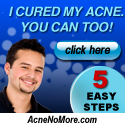Stop The Embarrassment: Treat Your Acne Rosacea Now
Signs and Symptoms of Acne Rosacea
There are certain contrasts between acne rosacea and acne vulgaris. As you probably know, acne vulgaris is the most common form of acne which seems to start with the onset of puberty and is characterized by the formation of whiteheads and blackheads. Acne rosacea, on the other hand, usually makes its first appearance between the ages of 30 and 50, is confined to the face — mostly the nose, cheeks, chin, forehead and eyelids — and is not associated with overactive oil glands.
Also Check: Identify Your Acne Before You Get Treatment
The lesions seen in acne rosacea consist of erythema, minute dilated blood vessels, papules and pustules. The color of the skin in the affected areas varies from bright to dull red, or it can even take on a purplish hue. At first the redness may last for just a few hours, but later as the condition progresses and recurrences continue, the color persists and can become permanent.
The hypertrophy of the sebaceous glands, especially on the nose, leads to thickening of the skin, increased visibility of the expanded follicles and an enlargement of the nose, so often associated with acne rosacea. Although most commonly seen in women, men have the most severe cases and are the ones that usually develop the disfiguring bulbous nose, known as rhinophyma. Oddly, sometimes rhinophyma is the only sign of the condition.
Also Check: Treating Pityriasis And Other Types Of Rosacea
People suffering from acne rosacea come to realize what aggravates their particular outbreaks and stop them. The most common stimulants are hot, spicy foods, hot beverages and alcohol. Exposure to the sun and to heat also seems to be aggravating factors.
Acne rosacea is not life-threatening, but it certainly does severely alter a person’s appearance.
Recommended for you: Natural And Herbal Remedies For Treating Acne
Complications Associated With Rosacea
There are only a few complications associated with acne rosacea. Sometimes, eye irritations can occur due to inflammation of the eyelashes or outer surface of the eyes. The membrane covering the lens (cornea) can become inflamed leading to impaired vision, but this rarely happens.
Recommended for you: Understanding And Caring For Body Acne
Treatment Options for Acne Rosacea
Topical and Oral Medication. There is no proven cure for rosacea since the exact cause of the disease is not known. Successful treatment is based on controlling the acne-like symptoms with the same topical and systemic medications used in treating regular acne.
The most effective treatment includes long term use of topical and oral antibiotics such as tetracycline which does seem to control the eruptions. The dosage of the antibiotic is slowly lowered to maintain control. In most cases, it can eventually be discontinued altogether without recurrence of the rosacea pimples. Of course, tetracycline should never be taken during pregnancy since the medication does affect the unborn child.
Also Check: How To Remove Your Acne
Laser and Surgery. Laser treatment has been successful in eliminating the enlarged facial blood vessels. This is a treatment that causes very little discomfort. Also, surgery can be used to remove the excess tissue associated with rhinophyma.
Other Treatment. The psychological and stress problems associated with acne rosacea should always be assessed and treated. The symptoms and severity are varied and can, at times, require the attention of a medical specialist.












0 comments:
Post a Comment